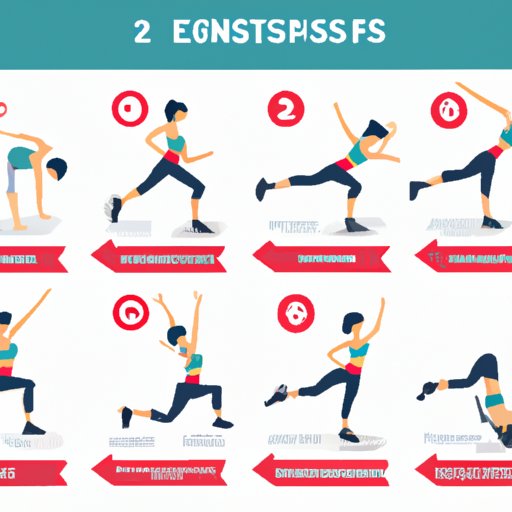How to Start Working Out: A Beginner’s Guide
Exercise is essential to maintaining good health and can provide a multitude of benefits, such as improving mood, reducing stress levels, and increasing longevity. However, starting a fitness routine can seem overwhelming and intimidating, especially for beginners. This article will guide you through the process of kick-starting your fitness journey, from setting realistic goals to staying motivated along the way.
5 Simple Steps to Kickstart Your Fitness Journey
Starting your fitness journey with the right mindset is crucial to achieving success. Here are five simple steps to help kickstart your fitness routine:
1. Set Realistic Goals
It’s essential to set realistic and achievable goals to avoid becoming discouraged or overwhelmed. Start by setting small goals that you can track and celebrate once you reach them.
2. Find a Workout Buddy
Exercising with a friend can provide you with a support system and make the process more enjoyable. Finding a workout buddy can be as simple as asking a friend or co-worker if they’re interested in joining you.
3. Create a Schedule
Scheduling your workout into your daily routine is critical to staying on track. Consider your personal schedule and try to find a time that works for you. Aim for consistency, so that you’re not tempted to skip your workout.
4. Track Your Progress
Tracking your progress can help you stay accountable and motivated. Keep a record of your workouts, and regularly assess your progress to stay on track towards your goals.
5. Other Tips
Consider investing in workout clothes and equipment you feel comfortable in. You can also explore different types of exercise or activities to diversify your routine and keep things exciting.
How to Pick the Right Workout Plan for You
Picking the right workout plan is critical to achieving your fitness goals. Here are some factors to consider when selecting a workout plan:
1. Aligns with Your Goals and Lifestyle
Consider your personal fitness goals and lifestyle when selecting a workout plan. Find a workout plan that fits within your schedule and aligns with your interests.
2. Intensity, Duration, and Frequency
Consider factors such as intensity, duration, and frequency when selecting a workout plan. You want to find a workout plan that is challenging but also feasible for your fitness level.
3. Type of Exercise
Consider the type of exercise you prefer and what aligns with your fitness goals. For example, if you want to improve cardiovascular health, consider incorporating cardio workouts into your routine.
The Importance of Stretching Before and After Exercise
Stretching and warming up before exercise can help reduce the risk of injury, while stretching after exercise can improve flexibility and prevent muscle soreness. Here are some stretches to add to your routine:
1. Warm-Up Stretches
Examples of warm-up exercises include jumping jacks, leg swings, and arm circles. Avoid overstretching during your warm-up as you don’t want to wear out your muscles before your workout.
2. Cool-Down Stretches
After exercising, focus on stretches that target the muscles you used. Examples include lunges and hamstring stretches.
Ways to Stay Motivated and Committed to Your Fitness Routine
Staying motivated and committed to your fitness routine is essential to achieving your fitness goals. Here are some tips to help you stay motivated:
1. Create a Workout Schedule that Works for You
Create a workout schedule that is realistic and fits your lifestyle. Stick to your schedule and make it a habit, so you won’t be tempted to skip your workout.
2. Have an Accountability Partner
An accountability partner can help you stay on track and provide the support you need to achieve your fitness goals. Consider asking a friend or hiring a personal trainer.
3. Celebrate Small Wins and Track Your Progress
Celebrate small wins and track your progress to stay motivated and committed to your fitness routine. Consider keeping a fitness journal or using a fitness app to track your progress.
4. Overcoming Obstacles
Obstacles such as injury, illness, or lack of motivation can prevent you from feeling motivated. Find ways to overcome these obstacles and adjust your workout routine accordingly.
Starting Small: How to Build a Fitness Routine from Scratch
Starting small and gradually building up to more challenging routines is an effective way to achieve long-term fitness goals. Here are some tips to get started:
1. Set Achievable Goals
Set achievable goals for yourself and gradually build your fitness routine from there. Consider starting with ten-minute workouts and gradually increasing your workout time.
2. Increase Intensity Gradually
Gradually increase the intensity of your workouts as you get stronger. Consider increasing your workout’s duration or frequency to make it more challenging.
3. Use Resources and Tools
Use resources and tools such as fitness apps, YouTube videos, or workout plans to help guide your fitness journey.
Conclusion
Starting a fitness routine can seem overwhelming, but by following these tips, you’re sure to have success. Remember to set achievable goals, find a workout buddy, create a schedule, stretch before and after exercise, stay motivated, and start small.
